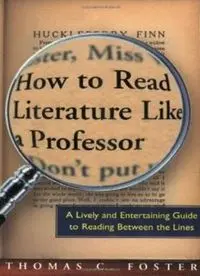
How to Read Literature Like a Professor: A Lively and Entertaining Guide to Reading Between PDF
Preview How to Read Literature Like a Professor: A Lively and Entertaining Guide to Reading Between
How to Read Literature Like a Professor A Lively and Entertaining Guide to Reading Between the Lines THOMAS C. FOSTER For my sons, Robert and Nathan Contents INTRODUCTION How’d He Do That? 1. Every Trip Is a Quest (Except When It’s Not) 2. Nice to Eat with You: Acts of Communion 3. Nice to Eat You: Acts of Vampires 4. If It’s Square, It’s a Sonnet 5. Now, Where Have I Seen Her Before? 6. When in Doubt, It’s from Shakespeare… 7. …Or the Bible 8. Hanseldee and Greteldum 9. It’s Greek to Me 10. It’s More Than Just Rain or Snow INTERLUDE Does He Mean That? 11. …More Than It’s Gonna Hurt You: Concerning Violence 12. Is That a Symbol? 13. It’s All Political 14. Yes, She’s a Christ Figure, Too 15. Flights of Fancy 16. It’s All About Sex… 17. …Except Sex 18. If She Comes Up, It’s Baptism 19. Geography Matters… 20. …So Does Season INTERLUDE One Story 21. Marked for Greatness 22. He’s Blind for a Reason, You Know 23. It’s Never Just Heart Disease… 24. …And Rarely Just Illness 25. Don’t Read with Your Eyes 26. Is He Serious? And Other Ironies 27. A Test Case ENVOI APPENDIX Reading List ACKNOWLEDGMENTS SEARCHBLE TERMS ABOUT THE AUTHOR PRAISE COVER COPYRIGHT ABOUT THE PUBLISHER Introduction How’d He Do That? MR. LINDNER? THAT MILQUETOAST? Right. Mr. Lindner the milquetoast. So what did you think the devil would look like? If he were red with a tail, horns, and cloven hooves, any fool could say no. The class and I are discussing Lorraine Hansberry’s A Raisin in the Sun (1959), one of the great plays of the American theater. The incredulous questions have come, as they often do, in response to my innocent suggestion that Mr. Lindner is the devil. The Youngers, an African American family in Chicago, have made a down payment on a house in an all-white neighborhood. Mr. Lindner, a meekly apologetic little man, has been dispatched from the neighborhood association, check in hand, to buy out the family’s claim on the house. At first, Walter Lee Younger, the protagonist, confidently turns down the offer, believing that the family’s money (in the form of a life insurance payment after his father’s recent death) is secure. Shortly afterward, however, he discovers that two-thirds of that money has been stolen. All of a sudden the previously insulting offer comes to look like his financial salvation. Bargains with the devil go back a long way in Western culture. In all the versions of the Faust legend, which is the dominant form of this type of story, the hero is offered something he desperately wants—power or knowledge or a fastball that will beat the Yankees—and all he has to give up is his soul. This pattern holds from the Elizabethan Christopher Marlowe’s Dr. Faustus through the nineteenth-century Johann Wolfgang von Goethe’s Faust to the twentieth century’s Stephen Vincent Benét’s “The Devil and Daniel Webster” and Damn Yankees. In Hansberry’s version, when Mr. Lindner makes his offer, he doesn’t demand Walter Lee’s soul; in fact, he doesn’t even know that he’s demanding it. He is, though. Walter Lee can be rescued from the monetary crisis he has brought upon the family; all he has to do is admit that he’s not the equal of the white residents who don’t want him moving in, that his pride and self-respect, his identity, can be bought. If that’s not selling your soul, then what is it? The chief difference between Hansberry’s version of the Faustian bargain and others is that Walter Lee ultimately resists the satanic temptation. Previous
